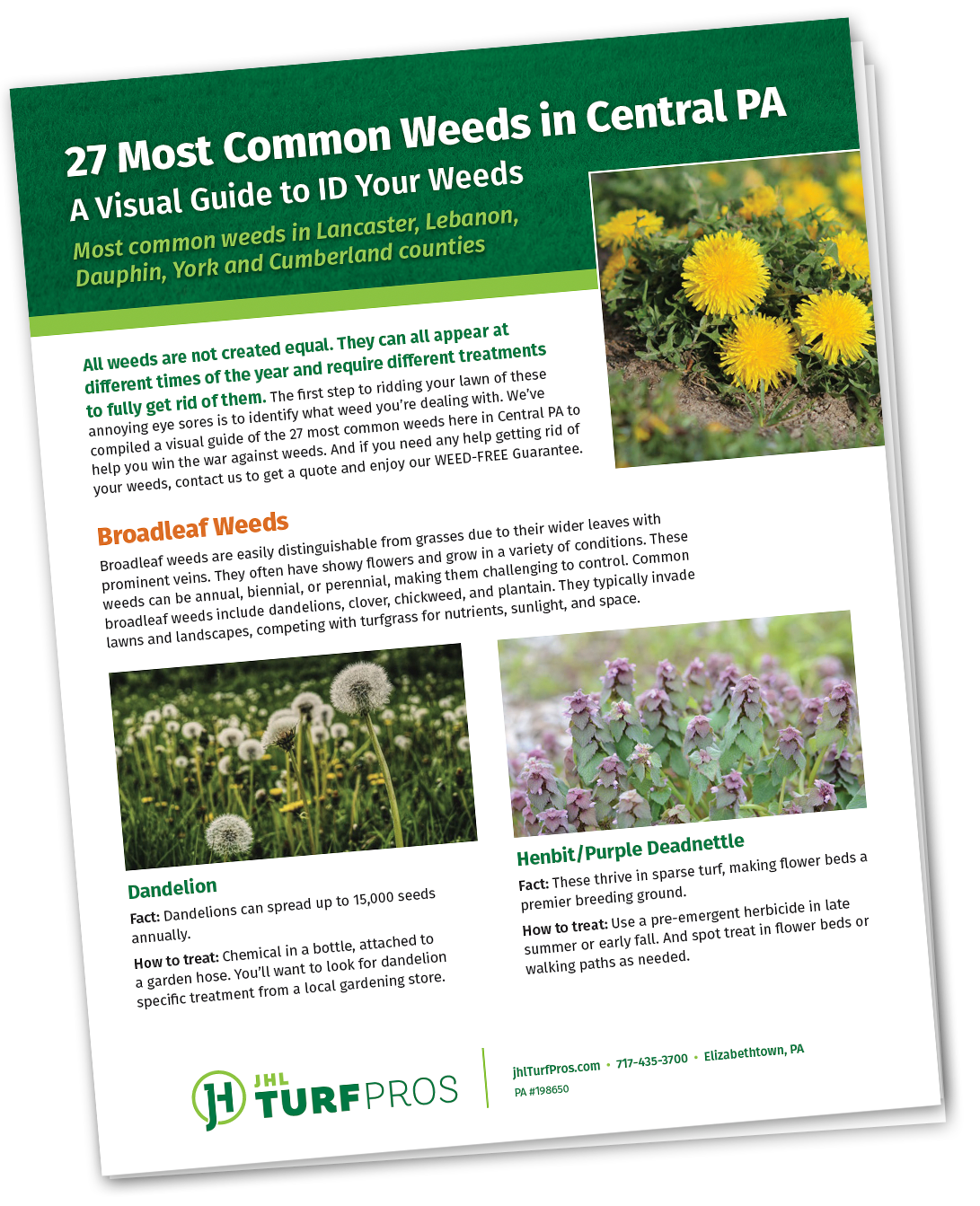
Broadleaf weeds can ruin the look and health of your lawn. Whether you’re dealing with dandelions, clover, or chickweed, JHL Turf Pros is here to help. In this guide, we’ll explain what broadleaf weeds are, how to identify them, and the most effective methods to remove and prevent them—without harming your grass.
What Are Broadleaf Weeds?
So, what are broadleaf weeds? These non-grassy plants are easy to spot thanks to their wide, flat leaves and distinct vein patterns. Unlike grassy weeds, they grow with noticeable separation from surrounding turf and often disrupt the uniform look of a healthy lawn.
Common types include dandelion, white clover, chickweed, and plantain. Broadleaf weeds can have a variety of life cycles—some are annual weeds, others are biennial or perennial broadleaf weeds. Their growth habits determine how they spread and how difficult they are to eliminate.
Understanding proper weed identification is crucial for selecting the right treatment. Perennial broadleaf weeds are known for returning season after season, making early detection and correct treatment essential for long-term control.

How Do You Kill Broadleaf Weeds?
Wondering how to kill broadleaf weeds without harming your lawn? The answer lies in using selective broadleaf herbicides. These products target broadleaf plants while leaving your turfgrass unharmed.
Look for herbicides that list active ingredients like 2,4-D, dicamba, or triclopyr—all effective against a wide variety of broadleaf weeds. Liquid formulations are ideal for full-lawn coverage, while spot treating works best for isolated patches.
Before applying any herbicide, carefully read and follow label instructions. Avoid mowing your lawn 2–3 days before and after application to ensure the weed can absorb the treatment properly. Apply when the weeds are actively growing, typically during mild, moist conditions.
Persistent or perennial weeds may require multiple applications. Always prioritize safety and precision when applying any herbicide carefully to protect both your lawn and the environment.
When to Apply Broadleaf Weed Killer
Timing is key when it comes to effective weed control. If you’re wondering when to apply broadleaf weed killer, the best time is in the fall, especially for perennial weeds. During this season, weeds prepare for dormancy and absorb herbicides more efficiently.
Spring can also be effective, particularly for annual weeds or visible early-season outbreaks. Avoid applying during extreme heat or right before rain, as these conditions can reduce herbicide effectiveness and increase the chance of runoff.
Aim to treat your lawn in the early morning when temperatures are cooler, winds are calm, and dew is present—this helps the herbicide stick to the weed’s surface. Avoid watering for 24 hours after application and never treat newly seeded lawns until the grass is well-established.
Consistent, well-timed applications are essential for applying broadleaf weed killer and maintaining a weed-free yard year-round.
How to Prevent Broadleaf Weeds in the Future
Broadleaf weed control in grass isn’t just about treatment—it’s about prevention. A healthy, dense lawn is your best defense against future weed invasions.
Start by maintaining proper lawn care practices. Mow at the correct height for your grass type, and water deeply but infrequently to promote strong root growth. Fertilize appropriately, avoiding excessive nitrogen, which can weaken grass and encourage weed growth.
Aerate the soil annually to reduce compaction, and overseed thin or bare areas to outcompete potential weed seedlings. A thick, thriving turf naturally resists weeds and makes it more difficult for them to take hold.
By implementing a consistent lawn care routine, you’ll not only control broadleaf weeds but also enjoy a lush, green lawn year-round.

When to Call a Lawn Care Professional
Sometimes, DIY treatments just aren’t enough. If you’ve tried killing weeds on your own and they keep coming back, it may be time to call in the pros.
You should also seek help if you’re unsure about weed identification or which herbicide is safe for your specific grass type. Professionals have access to commercial-grade products and expertise to apply them safely and effectively.
At JHL Turf Pros, we provide expert broadleaf weed control in grass. Our team will assess your lawn’s conditions, identify the weed type, and create a tailored plan for how to get rid of broadleaf weeds—once and for all.
Trust JHL Turf Pros for Weed-Free Lawns
With years of experience treating Pennsylvania lawns, JHL Turf Pros knows how to handle broadleaf weeds safely and efficiently. We tailor each lawn care plan to your yard’s unique needs—taking into account your grass type, location, and time of year.
Whether you’re battling dandelions or trying to control broadleaf weeds before they spread, our team has the solution. Let us help you restore your yard to a thick, green lawn you’ll love coming home to.
Request a Lawn Evaluation Today
Say goodbye to unsightly weeds and hello to a lush, healthy lawn. JHL Turf Pros offers expert weed control services tailored to your yard. Request your free lawn evaluation today and take the first step toward broadleaf weed-free grass.

FREE VISUAL GUIDE:
27 Most Common Weeds in Central PA
Which of these weeds do you have in your lawn? Use this weed guide to identify common weeds that grow in Lancaster, Lebanon, Dauphin, York and Cumberland Counties.
